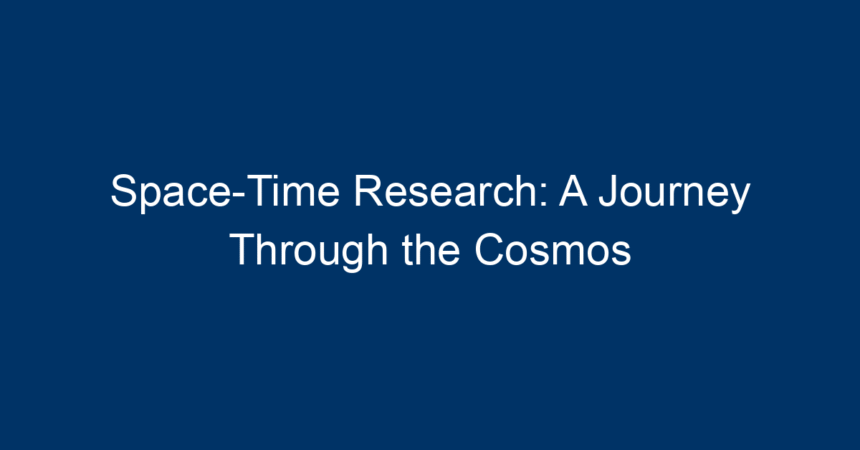The universe is an unfathomable tapestry woven from threads of time and space, each influencing the other in myriad ways. The field of space-time research delves deep into understanding this intricate relationship, unlocking secrets that have puzzled humanity for centuries. In this article, we will embark on a journey through the cosmos, exploring the concept of space-time, its significance in physics, recent advancements, and future horizons.
Understanding Space-Time
What is Space-Time?
At its core, space-time is a four-dimensional continuum that combines the three dimensions of space (length, width, height) with the dimension of time. This revolutionary concept emerged from Albert Einstein’s theories of relativity, which fundamentally altered our perception of the universe. Instead of viewing time and space as separate entities, Einstein proposed they are interwoven, influencing each other in profound ways.
The Role of Space-Time in Physics
The interrelationship between space and time has significant implications in physics. For instance, the effects of gravity can warp space-time, leading to phenomena like time dilation, where time moves slower in strong gravitational fields. These principles govern everything from the orbits of planets to the behavior of light across the cosmos.
Key Concepts in Space-Time Research
The Fabric of Space-Time
Understanding space-time as a "fabric" is a prevalent metaphor in space-time research. This fabric can be bent, stretched, and warped by massive objects, producing what we perceive as gravity. For example, the Earth orbits the Sun not merely because of an invisible force, but due to the curvature of space-time caused by the Sun’s mass.
Black Holes and Singularities
One of the most fascinating areas of space-time research is the study of black holes. These cosmic phenomena occur when enough mass is compressed into an infinitely small point, known as a singularity, creating a gravitational pull so strong that not even light can escape. The event horizon marks the boundary where space-time behaves differently, challenging our understanding of physics.
Quantum Mechanics and Space-Time
The relationship between quantum mechanics and space-time is another frontier in space-time research. While general relativity describes gravity at macroscopic scales, quantum mechanics explores the subatomic realm. Reconciling these two frameworks has been one of the biggest challenges for physicists, leading to the development of theories like quantum gravity.
Recent Developments in Space-Time Research
Advancements in Black Hole Studies
Recent advancements in space-time research have led to groundbreaking discoveries in black hole studies. The Event Horizon Telescope (EHT) successfully captured the first-ever image of a black hole, providing concrete evidence to support theories regarding their existence and properties. These findings have opened new avenues for exploration, from understanding black hole formation to their role in galaxy formation.
Gravitational Waves
Following Einstein’s predictions, the detection of gravitational waves has been a game-changer in space-time research. These ripples in space-time, produced by colossal cosmic events such as merging black holes or neutron stars, provide invaluable information about the universe’s most violent occurrences. The LIGO (Laser Interferometer Gravitational-Wave Observatory) has become a key player in this field, allowing scientists to explore the cosmos in entirely new ways.
The Cosmic Microwave Background Radiation
The study of Cosmic Microwave Background (CMB) radiation remains a cornerstone of space-time research. This faint glow, the afterglow of the Big Bang, provides critical insights into the universe’s early stages. Recent findings from missions like the Planck satellite have refined our understanding of the universe’s expansion, age, and composition.
The Future of Space-Time Research
The Quest for Quantum Gravity
As scientists continue to explore the cosmos, the quest for a theory of quantum gravity will remain at the forefront of space-time research. This endeavor aims to merge the principles of quantum mechanics and general relativity, potentially leading to new technologies and a deeper understanding of the fundamental workings of the universe. Theories like string theory and loop quantum gravity are already making strides in this area.
Exploring Other Dimensions
Some theoretical frameworks posit the existence of additional dimensions beyond the familiar four. These theories suggest that the universe may have up to eleven dimensions, with implications that could revolutionize our understanding of space and time. Exploring these additional dimensions could provide clues to unanswered questions about dark matter, dark energy, and the universe’s ultimate fate.
Space Exploration and Technology
As we stand at the cusp of a new era in space exploration, the insights gained from space-time research are invaluable. Missions targeting Mars, the moons of Jupiter, and beyond will allow scientists to test theories of space-time in various environments, expanding our knowledge and sparking innovations in technology. Advancements such as quantum computing and AI could one day facilitate groundbreaking discoveries in this field.
Actionable Insights
-
Stay Informed: For those interested in the cosmos, keeping up with the latest developments in space-time research is essential. Subscribing to scientific journals, following relevant blogs, and attending lectures can enhance your understanding.
-
Engage with Communities: Joining forums or online communities centered around space research can lead to insightful discussions, resource sharing, and collaboration on projects of interest.
-
Support Education: Engaging with educational programs and initiatives focused on physics and space sciences can inspire future generations to explore the wonders of space-time, encouraging broader public interest and funding for research.
-
Participate in Citizen Science Projects: Many organizations offer citizen science opportunities, allowing individuals to contribute to ongoing research in astronomy and space-time studies. This participation can be fulfilling and impactful, aiding professional scientists while enriching personal knowledge.
- Promote STEM Education: Advocating for strong STEM (Science, Technology, Engineering, and Mathematics) education plays a significant role in nurturing young minds who will pioneer future discoveries in space-time research.
Conclusion
Space-time research offers an exhilarating glimpse into the mechanics of the universe, unraveling complex relationships between time, space, and gravity. As we continue to push the boundaries of knowledge, our understanding of the cosmos expands, revealing more mysteries and possibilities. By engaging with the ongoing discourse, supporting educational initiatives, and promoting public interest in science, we contribute to a collective journey that may one day unlock the deepest secrets of the universe. Whether you’re a novice or a seasoned astrophysicist, the cosmos awaits, inviting each of us to explore its vastness through the lens of space-time research.




